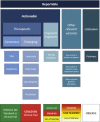Standardized decision support in next generation sequencing reports of somatic cancer variants
- PMID: 24768039
- PMCID: PMC5528527
- DOI: 10.1016/j.molonc.2014.03.021
Standardized decision support in next generation sequencing reports of somatic cancer variants
Abstract
Of hundreds to thousands of somatic mutations that exist in each cancer genome, a large number are unique and non-recurrent variants. Prioritizing genetic variants identified via next generation sequencing technologies remains a major challenge. Many such variants occur in tumor genes that have well-established biological and clinical relevance and are putative targets of molecular therapy, however, most variants are still of unknown significance. With large amounts of data being generated as high throughput sequencing assays enter the clinical realm, there is a growing need to better communicate relevant findings in a timely manner while remaining cognizant of the potential consequences of misuse or overinterpretation of genomic information. Herein we describe a systematic framework for variant annotation and prioritization, and we propose a structured molecular pathology report using standardized terminology in order to best inform oncology clinical practice. We hope that our experience developing a comprehensive knowledge database of emerging predictive markers matched to targeted therapies will help other institutions implement similar programs.
Keywords: Cancer; Genomics; Next-generation sequencing; Report; Variant annotation.
Copyright © 2014 Federation of European Biochemical Societies. Published by Elsevier B.V. All rights reserved.
Figures





References
-
- Ascierto, P.A. , Schadendorf, D. , Berking, C. , 2013. MEK162 for patients with advanced melanoma harbouring NRAS or Val600 BRAF mutations: a non-randomised, open-label phase 2 study. Lancet Oncol.. 14, 249–256. - PubMed
-
- Carpten, J.D. , Faber, A.L. , Horn, C. , 2007. A transforming mutation in the pleckstrin homology domain of AKT1 in cancer. Nature. 448, 439–444. - PubMed
Publication types
MeSH terms
LinkOut - more resources
Full Text Sources
Other Literature Sources
Medical

